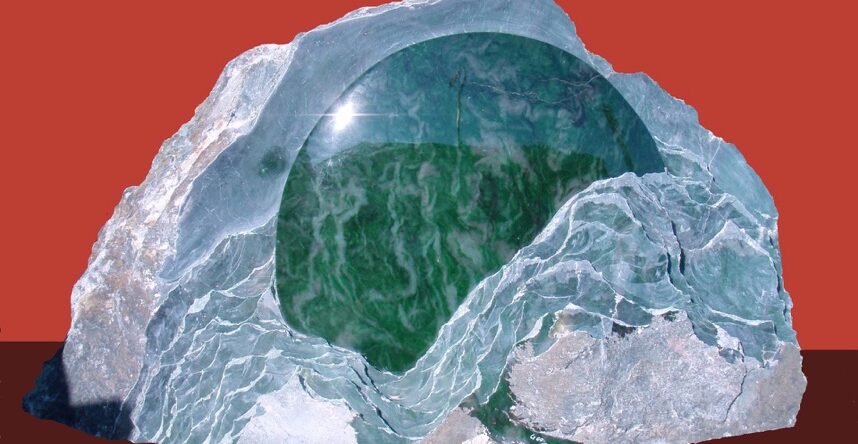

The following is an interview with sculptor Stuart Jacobson of McMinnville, Oregon. Here, he responds to a questionnaire regarding his experience as a stone sculptor.
I’ve spent most of my adult life searching for who I am. I tried to mold myself into what appeared to be a “normal” logical, left brain thinking person. Of course it didn’t work out real well and caused me to make numerous job changes. These included being a home remodeler, a landscape designer, a stockbroker, running a landscape maintenance business and a water features business. Five years ago I finally stopped struggling and gave myself over to becoming an artist. This odyssey from the world of “normalcy” began on a family vacation while we were driving along the Oregon coast. We came upon the most incredible monumental stone sculptures I had ever seen, right beside the highway at the Freed gallery. It was as though I had been struck by lightening, as I seemed to be totally transfixed, unable to remove my eyes from the sculptures. I lost all sense of time and space. Since I was driving at the time, and pulling a travel trailer as well, this was not a good thing. We began drifting off the road into a ditch. I didn’t fully recover and regain consciousness until I finally heard a chorus of screams from my wife Peggy and the kids. Just in the nick of time I pulled us back onto the highway, but my life has never been the same since. These amazing sculptures were by Kazutaka Uchida. I can’t explain it, but I connected with this work like no other I had ever seen before. I decided then and there that I must meet this man, even if it meant flying to Japan to do it. An amazing moment of synchronicity happened a few weeks later, when Peggy noticed an announcement for Camp Brotherhood, featuring Kazutaka Uchida. Two weeks at the symposium, and my life was permanently changed.
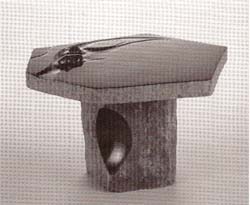
My artistic role models are Uchida, Noguchi, Hepworth, and Brancusi. John Denver was once quoted as saying to an interviewer, “To know my songs is to know me.” The same is pretty true for me as well. My sculptures mostly reflect who I am, who I am trying to become, or just those things that I admire in others or in nature. Uchida once offered me a profound piece of advice that I have taken to heart, incorporating it into the foundation of my work. “The most important thing is, what are you trying to say?” I have never made a sculpture without being able to satisfactorily answer that question. Hardly a day passes that I don’t reflect upon that advice.
Becoming an artist caused me to become much more of a spiritual person as well. Reading The Artist’s Way, by Julia Cameron changed my whole concept of who I am and where my inspiration comes from. I’ve heard many articulate people describe a similar sentiment, but I most vividly recall Brian Berman once describe himself as the “invisible sculptor”. His explanation was that he simply shows up and lets the creativity of the universe flow through him. That’s an excellent way of describing my sculpting style as well. I do run my ideas through several filters before I allow myself to proceed. Is there an important message or story to tell by creating this piece? Is the message uplifting and positive in nature? Can it be told simply, and conveyed in such a way, that others will understand what I’m trying to say, without the use of words?
I describe my work as mostly nonrepresentational and conceptual. It has a very contemporary feel. I strive for simplicity, always looking for the most concise way to articulate a theme. I look for a universal way of expressing a message through the use of symbols. I’m a pretty uncomplicated person and can get totally fouled up if I try to make something too complex. So as I’m working, I constantly ask myself the question, is this really necessary to convey my message? Every time I consider a new element or change to the sculpture I ask myself, will this reinforce or detract from my theme?
I started out as a direct carver. As I’ve gained experience and confidence, I am now quite comfortable as an indirect carver as well. I do a great deal of drawing. I’m not very good at it. But that doesn’t stop or discourage me. I’m only trying to capture an idea. I’m not trying to make a perfect drawing. I don’t really edit my ideas very much. I just try to get them down on paper. My approach is a little bit like the photographer who takes an entire role of film, hoping for one really wonderful shot. My ideas come to me in a variety of ways. I take private time by going for a walk, almost every day. This is when a major amount of ideas come to me, as well as the solutions to problems or design challenges that I may be experiencing. Most mornings I write pages in a journal. This helps to clear out a lot of the internal chatter going on inside my head, allowing more space and clarity to generate ideas. I also get some of my best ideas while riding in the car. Peggy and I have reached an understanding on this. I am free to design all that I want to, as long as she does all the driving! I’ve learned to enjoy being chauffeured. I also really enjoy the creative hits that I get out of seeing other people’s work. So going to galleries or museums is something I try to do regularly. The NSSSA Symposium is another wonderful time to get charged up with new ideas and techniques as well. Learning a new technique will spark a whole host of new ideas. “Cycle of Life” was the direct result of Laura Alpert’s design class. I usually have many more ideas than time to carve them. The benefit to this is that I am forced to discard all but my best ideas.
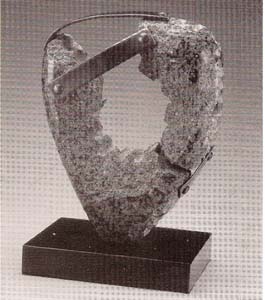
How do you develop ideas? A visual image may come to mind. I ask, what does this mean? What could I say by using this image? Other times I ask myself how I could express what I’m feeling. What does this feeling look like? An example of the way I design is the way I developed “Balance” [see cover photo]. I am inspired by George Tsutakawa’s sculptures. In this case I was specifically inspired by some of his stacked wooden pieces. I wanted to try playing with a similar assemblage of stone pieces. I started playing around with ideas for stacked stones. I decided to place those stacked stones within a larger form, to make it more interesting through the use of positive and negative spaces. Purely by chance, this larger form took the shape of an abstracted human heart. I asked, what does it mean? Why do it? I then constructed a story that successfully answered those questions, and helped me to make the rest of my design decisions. This piece describes my perception about the three key elements to me experiencing a well-balanced life, and a balanced heart. The three black stones represent the body, mind, and the spirit. The lowest upright stone represents the body; the mind sits on top of the body and is cup shaped as the receptacle of knowledge. The spirit grows out of the mind and ascends upward. When my body, mind and spirit are in balance, I am in balance. The exterior of the heart is rough and textured, representing the junk that life throws at me sometimes. The inside of the heart is smooth and polished, representing the inner serenity I feel when I am truly in balance.
Another piece, called “Forgiveness,” exemplifies how I strive to utilize universal symbols to convey a theme. It’s a broken heart that has been mended together through the act of forgiveness. These stones were the broken fragments that came from the middle of the “Balance” sculpture. I was cutting, drilling and really hacking away at this stone. About half way through this process I decided to try to save some of this material for a possible later project. As I had been working on these stone fragments, they were subjected to a great deal of brutality and violence by me. When I had finished, whenever I looked at them, they always looked like a broken heart. I used to share a studio with Devin Field. I admired his steel sculptures and wanted to do a mixed media piece using metal steel ever since. But I could never figure out what would be a satisfactory reason to do this. I couldn’t answer my fundamental question “why”. So in this case, as I thought about mending the heart using steel straps, the answer came to me with the concept of forgiveness.
What are you trying to express? These sculptures are like meditations for me. They reflect what I focus on trying to become or strive to be. I know that a lot of the joy I feel comes out in my work. That’s why something as negative as a brutalized and broken heart gets transmuted into something positive.

Are you working part time or full time? I’m a full time artist. I am truly grateful for the fact that I get to spend so much time working at my art. But it makes me feel a tremendous responsibility to make the most of my opportunity. I see so many other talented artists that don’t have the time that I do to spend on their art. This gratitude I feel and the resulting responsibility makes me obsessively driven. I push myself pretty hard. I have to make a conscious effort to step back in order to achieve balance in my life. I regret that I came to become an artist relatively late in life and feel that I must use every moment that I am given to the utmost. What stones do you prefer to carve? One of the reasons that I sculpt is that it is another way of leaving a legacy or experiencing a form of immortality. This is one of the reasons I really like the hard stones. Basalt, andesite, granite, diorite are favorites. I’d also love to try black limestone with white veins. I prefer stones that are dark gray, mostly black, or completely black and tend to stay away from highly patterned and brightly colored stones. The simplicity of the designs and concepts that I strive to articulate generally work better in stone that isn’t too bright or highly patterned. The other thing is, I started out doing garden fountains and sculptures, so I got used to working in the hard stones right from the start. I also thought that it made sense to either collect or pay 10 cents a pound for basalt while I was learning what I was doing, rather than pay big bucks for more exotic stone. Recently I purchased quite a bit of Mahogany Granite, a dark gray and black granite. And I have several tons of basalt waiting for me as well. It seems like it’s easier to sell outdoor sculpture, so I think it beneficial for me to be experienced in working stone appropriate for outdoor placement.
What scale do you prefer? Big. I’m a big movement kind of guy. While I appreciate small detail work, it’s not my forté. I tried small detailed carving with lapidary tools when I was a child, but couldn’t get comfortable with it. When I tried an angle grinder and an air hammer at my first symposium, something clicked for me. Peggy claims that I’ve never met a power tool that I didn’t like. Don’t tell her I admitted it, but it’s true. I’ve been making sculptures that one or two people can move. Table top, pedestal and floor standing pieces. The heaviest one to date has been “Chi”, a 4’ tall, 800-lb. basalt column carved into about a 600-lb. sculpture. I don’t have any heavy lifting equipment yet except for an engine hoist. This is about to change, since I just received a large commission that will require me to carve an 8’ tall 4-5 ton piece of columnar basalt. (It’s an 8 tall basalt column with a 1’ thick slab sliced out of through the upper portion of the two remaining pieces. The cut edges will all be given a 4” bevel and the inside surfaces polished. A 20” sphere of contrasting material will be suspended between the two “halves” and within the larger hole. Called “The Heart of The Valley,” it represents and honors Corvallis, the river and the valley, and will be set in the Corvallis Riverfront Commemorative Park.) I’m really excited about it because I’ve always wanted to do a large public art piece. But I haven’t geared up for it yet. So now I’ve really put my feet to the fire and need to make some serious improvements—like pouring a concrete slab for starters, and I’ll probably get a gantry crane. Right now my sculpture studio is my symposium tent! Stone and tools, etc. are stored in the garage. My next piece, called “Eclipse,” will be a 5” thick by 9’ tall dark gray black granite slab. It will weigh 1-2000 lbs.
What is your working process (do you have several pieces going at once or just one)? I’ve done it both ways. I prefer to have several going at once. The variety makes it more interesting. It also gives me time to resolve design issues and consider what I’m going to do next on a piece. But because I am under-equipped for the type and size sculpture I prefer to do, it takes a long time to get a piece done. Because of this, I frequently end up working on just one at a time. With the Corvallis Riverfront Commemorative Park commission, I’ve reached a turning point in my career. So now I’ll be making some significant upgrades to my equipment and facilities. That will also make it easier to work on multiple pieces.
What tools do you primarily use? Angle grinders seem to be one of my best friends. 4 1/2” or 5” are the most frequently used. the middle. A 2’ hole will be bored ferring my 9 point bushing tool. But I seem to work faster with just cutting and grinding.
The majority of my time is spent cutting, grinding, and polishing.

Where do you exhibit you work? I usually have at least some work at the five galleries listed in my resume. I also participate in the occasional sculpture invitational, and once each year, in October, I have a home studio show. This year I’ll be showing work at the Clackamas Sculpture 2000 Invitational in April and May, and a two person show in August with a painter at the Waterstone Gallery in Portland.
How much work do you complete in a year? I’m a pretty slow sculptor. It has to do with the hardness of the stones that I prefer to carve. I was real slow when I started but have gotten faster. I’ve only done somewhere around 26 pieces in the 5 years that I’ve been carving. Since I’ve pretty well stopped doing fountains and other craft items, I now have much more time to devote to sculpting, I completed 11 pieces last year. I now find that these days I’m spending more and more time applying for art commissions. I did my first public commission (a bench called “Yuen”) for the City of Beaverton Community Center last fall. Unfortunately it takes me at least two days for every proposal that I send out. So I’ve learned to be pretty selective about which ones I try for. And the final selection for the Corvallis proposal took months to put together, since I proposed four different pieces and made a small scale sculpture of one of the pieces.
Do you teach your artform? Not in any structured way. The home studio show that I do has an educational component to it, so I do a great deal of show and tell at that time. In addition, this year I’ll do a little instructing at Silver Falls Symposium.
What are you looking forward to (flights of fancy)? I am hopeful that I’ll get to do more public art pieces of a monumental nature. It’s not so much that I want to do large pieces for the ego stroke. It has more to do with feeling like I have something to say and wanting to opportunity to share it with a large audience.
If things go really well…I’ve always had the long-term dream of doing work worthy of being included in museum collections. And for that to happen in my lifetime would be way cool!
I just want to say…. The fact that I didn’t study art in college has been a hindrance. It would have helped me a great deal, especially design theory and art history. But in some ways it has also benefited me. I feel much more liberated by not being weighed down with too much knowledge and not being held back from knowing that something couldn’t be done. This has allowed me to be very experimental, which keeps my interest level high. It is my desire to do really innovative work, breaking new ground, and to reinvent myself every so often. One upcoming change for me that I see on the horizon is to do some pieces, which are much less controlled, and much more gestural and spontaneous in nature. This will involve some much rougher work with sawing, hacking and breaking off chunks of stone. Much less finished and refined. We’ll call it my “slasher period”. Don’t get me wrong, I’m very proud and satisfied with my work to date. I just think that in order for me to make the next big leap, I must to try to be less controlled, take more chances, and risk complete failure more often. A way of explaining it is, it’s like listening to a singer sing a beautiful song, but who is trying really hard to be in control and hit the right notes on key. Contrast that with someone who is really belting it out and pushing the limits. They’re going for it! They are giving it everything they’ve got and not holding anything back. The first is pretty. The second is fiery and passionate, and cannot be duplicated. To listen to them, the difference is remarkable. The latter is who I want to be.




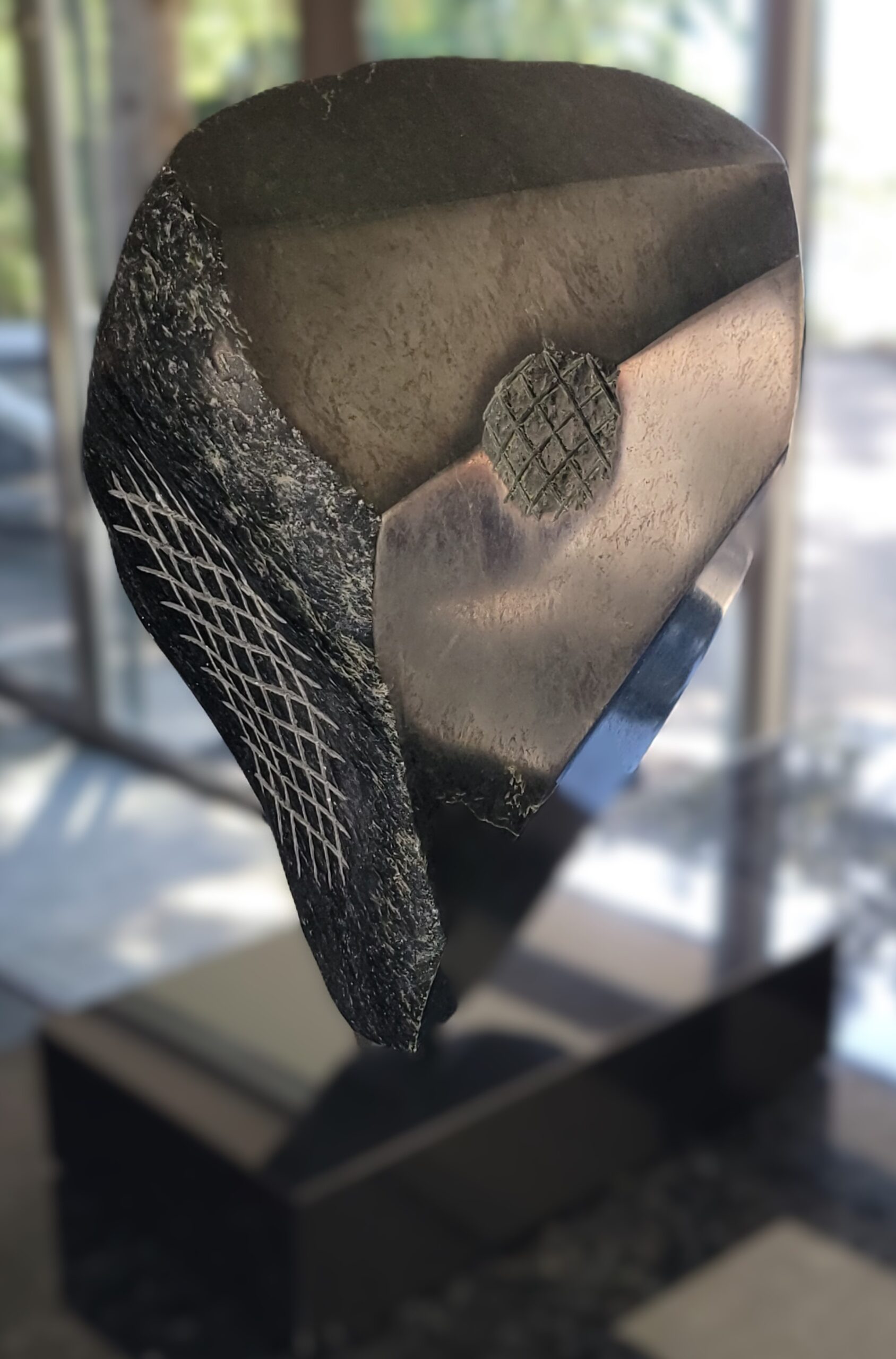
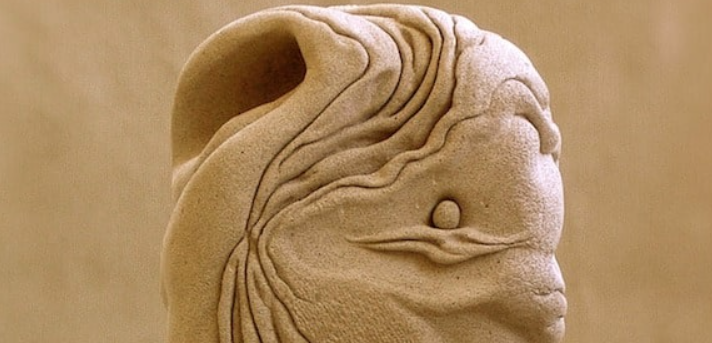
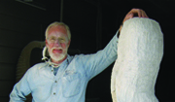
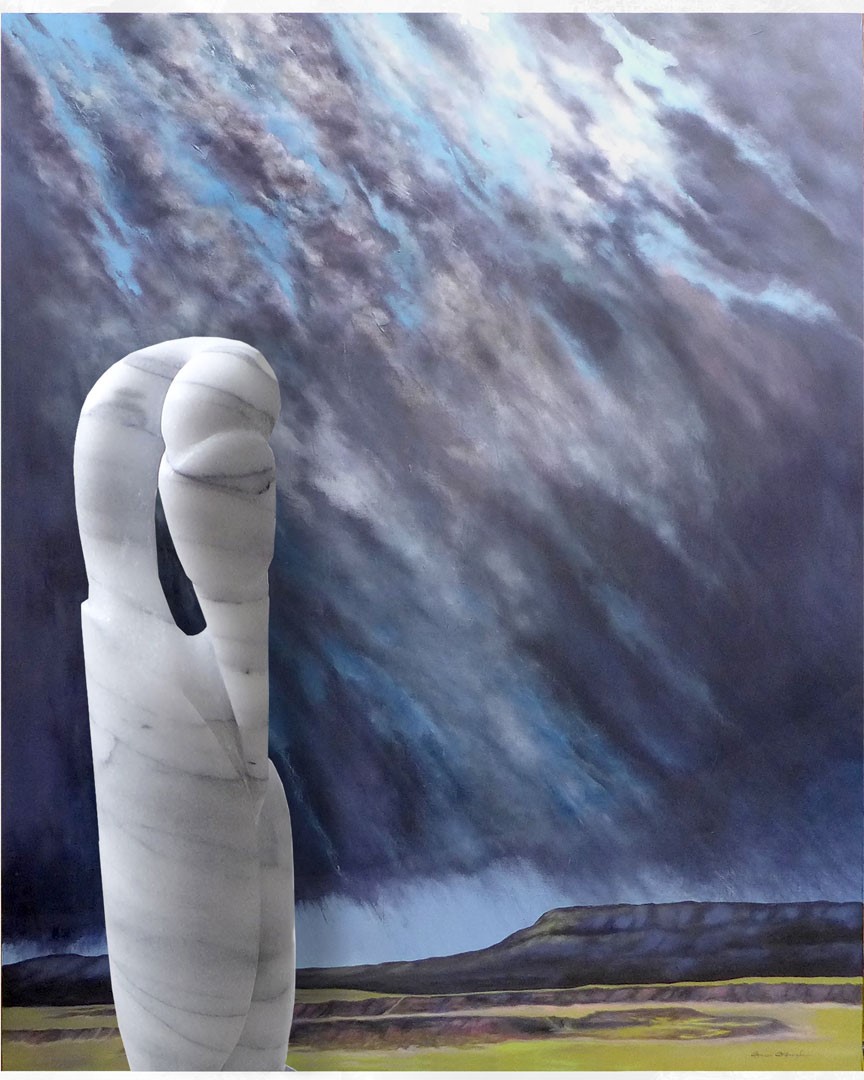

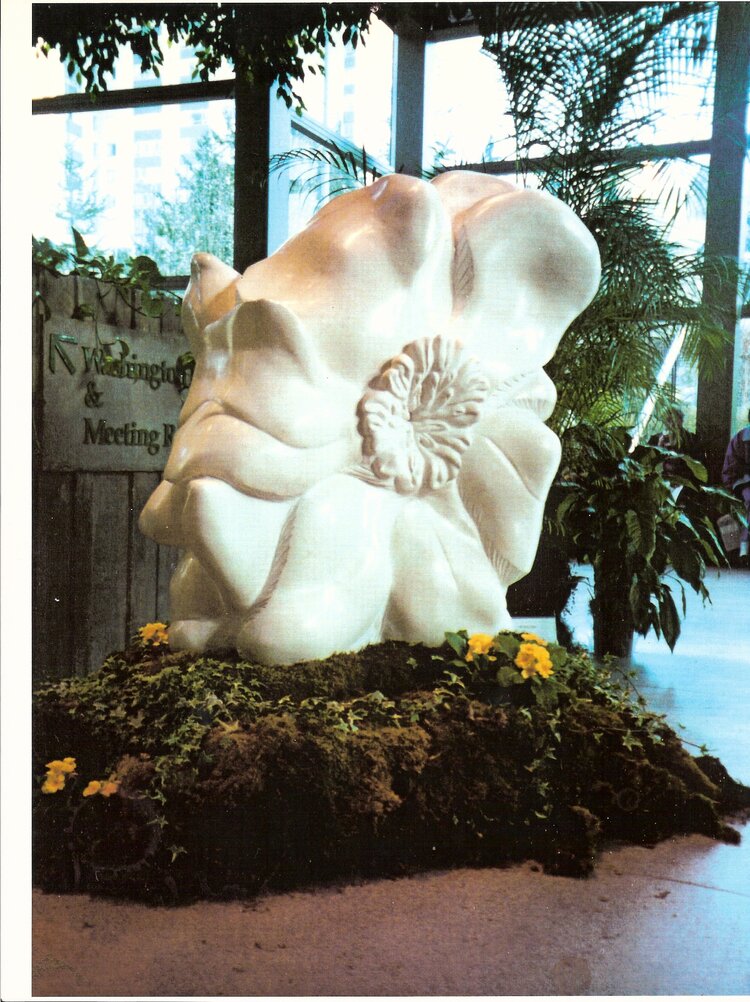

We need some kind of descriptive text here.